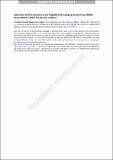Calibration and Performance of the REgolith X-Ray Imaging Spectrometer (REXIS) Aboard NASA’s OSIRIS-REx Mission to Bennu
Author(s)
Hong, Jaesub; Binzel, Richard P.; Allen, Branden; Guevel, David; Grindlay, Jonathan; Hoak, Daniel; Masterson, Rebecca; Chodas, Mark; Lambert, Madeline; Thayer, Carolyn; Bokhour, Ed; Biswas, Pronoy; Mendenhall, Jeffrey A.; Ryu, Kevin; Kelly, James; Warner, Keith; Lim, Lucy F.; ... Show more Show less
Download11214_2021_853_ReferencePDF.pdf (9.411Mb)
Open Access Policy
Open Access Policy
Creative Commons Attribution-Noncommercial-Share Alike
Terms of use
Metadata
Show full item recordAbstract
Abstract
The REgolith X-ray Imaging Spectrometer (REXIS) instrument on board NASA’s OSIRIS-REx mission to the asteroid Bennu is a Class-D student collaboration experiment designed to detect fluoresced X-rays from the asteroid’s surface to measure elemental abundances. In July and November 2019 REXIS collected ∼615 hours of integrated exposure time of Bennu’s sun-illuminated surface from terminator orbits. As reported in Hoak et al. (Results from the REgolith X-ray Imaging Spectrometer (REXIS) at Bennu, 2021) the REXIS data do not contain a clear signal of X-ray fluorescence from the asteroid, in part due to the low incident solar X-ray flux during periods of observation. To support the evaluation of the upper limits on the detectable X-ray signal that may provide insights for the properties of Bennu’s regolith, we present an overview of the REXIS instrument, its operation, and details of its in-flight calibration on astrophysical X-ray sources. This calibration includes the serendipitous detection of the transient X-ray binary MAXI J0637-430 during Bennu observations, demonstrating the operational success of REXIS at the asteroid. We convey some lessons learned for future X-ray spectroscopy imaging investigations of asteroid surfaces.
Date issued
2021-11-17Department
Lincoln Laboratory; Massachusetts Institute of Technology. Department of Earth, Atmospheric, and Planetary Sciences; Massachusetts Institute of Technology. Department of Aeronautics and Astronautics; MIT Kavli Institute for Astrophysics and Space ResearchPublisher
Springer Netherlands
Citation
Space Science Reviews. 2021 Nov 17;217(8):83
Version: Author's final manuscript